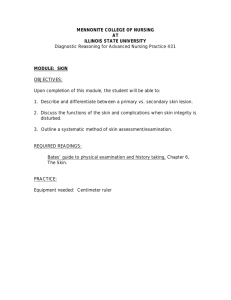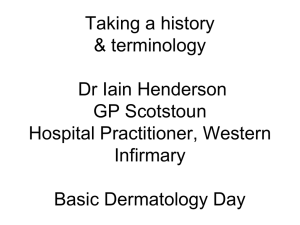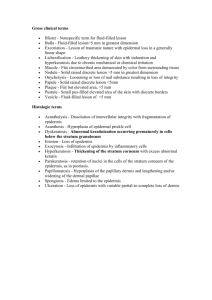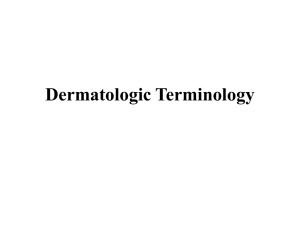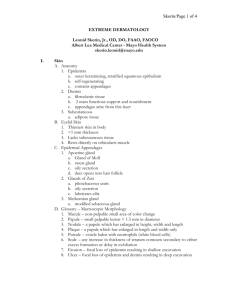Dermatological History and Examination
advertisement
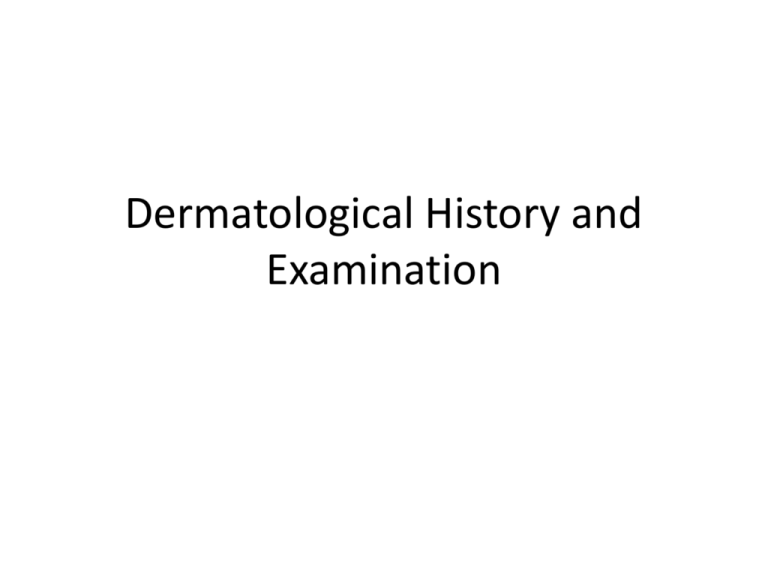
Dermatological History and Examination History of a rash • Key questions: – – – – – – – When did it start? Does it itch, burn, or hurt? Where on the body did it start? How has it spread (pattern of spread)? How have individual lesions changed (evolution)? Aggravating factors? Previous treatments and response? History of a growth • Key questions: – How long has the lesion been present? – Has it changed, grown, bled, itched, or failed to heal? • General history of present illness as indicated by clinical situation – Acute illness syndrome (fever, sweats, chills, headache, nausea, vomiting, cough, runny nose, etc.)? – Chronic illness syndrome (fatigue, anorexia, weight loss, malaise)? • Review of systems – particular attention to symptoms indicating a possible connection between cutaneous signs and disease of other organ systems • Review of systems for growths suspicious for, or associated with, malignancy: – particular attention to symptoms of metastasis (weight loss, fevers, chills, night sweats, headache, swollen glands, abdominal pain, abnormal stooling, bone pain, etc.) Medication history • All prescription, nonprescription, and "complementary" medications, with particular attention to those that temporally correspond to the onset of the eruption • Allergies Past medical history • • • • Illnesses Operations Atopic history (asthma, hay fever, eczema) Family medical history, particularly of skin disorders and of atopy • Family history of skin, or other, cancers • Social history with particular reference to occupation, hobbies, sun exposure, pet exposure, tobacco smoking, alcohol consumption, recreational drugs, travel, sexual orientation and exposures Examination • • • General Inspection: Does the patient appear ill? Physical examination: detailed examination of the skin, hair, nails, and mucous membranes Important features of a skin lesion: – – – – Type of lesion: macule, papule, nodule, vesicle, etc. (see Table 4-2 below) Shape of individual lesions: annular, iris, arciform, linear, round, oval, umbilicated, etc. Arrangement of multiple lesions: isolated, scattered, grouped, linear, etc. Distribution (be sure to examine scalp, mouth, palms, and soles) • • Extent of involvement: circumscribed, regional, generalized, universal? What percentage of the body surface is involved? Pattern: symmetry, exposed areas, sites of pressure, intertriginous areas? – Color – Consistency and feel of lesion: soft, doughy, firm, hard, "infiltrated," dry, moist, mobile, tender, warm? – Anatomic components of the skin primarily affected: Is the process epidermal, dermal, subcutaneous, appendageal, or a combination of these? • General physical examination as indicated by the clinical presentation and differential diagnosis, with particular attention to vital signs, lymphadenopathy, hepatomegaly, splenomegaly, joints, etc. Papule • A papule is a solid, elevated lesion < 0.5 cm in size Papule. Multiple, well-defined papules of varying sizes are seen. Flat tops and glistening surface are characteristic of lichen planus Plaque • A plaque is a solid plateau-like elevation that has a diameter > 0.5 cm Plaque. Well-demarcated pink plaques with a silvery scale representing psoriasis vulgaris. Nodule • On the skin, a nodule is a solid, round or ellipsoidal, palpable lesion that has a diameter > 0.5 cm. • Depth of involvement and/or substantive palpability, rather than diameter, differentiates a nodule from a large papule or plaque. Nodule. A nodular BCC with welldefined, firm nodule with a smooth and glistening surface through which telangiectasia can be seen. Cyst • A cyst is an encapsulated cavity or sac lined with a true epithelium that contains fluid or semisolid material (cells and cell products such as keratin). • Spherical or oval shape • Depending on the nature of the contents, cysts may be hard, doughy, or fluctuant. • A clinical example is a cystic hidradenoma Cyst. A bluish colored resilient cyst filled with a mucous-like material on the cheek is a cystic hidradenoma Wheal • A wheal is a swelling of the skin that is characteristically transient, disappearing within hours. • Also known as hives or urticaria • It is the result of oedema produced by the escape of plasma through vessel walls in the upper portion of the dermis. • Wheals: – – – – – Variable size Variable shapes Borders are sharp but not stable Pink to pale red in colour. Soft to firm depending on the extent of oedema present. • A clinical example is dermatographism Wheal. A sharply demarcated wheal with a surrounding erythematous flare occurring within seconds of the skin being stroked. Ulcers • An ulcer is a defect in which the epidermis and at least the upper dermis has been removed. – Location of the ulcer, such as on the medial aspect of the ankle or over pressure points, may be telling – Borders of the ulcer may be rolled, undermined, punched out, jagged, or angular – The base may be clean, ragged, or necrotic – Discharge may be purulent, granular, or malodorous – Surrounding skin may be red, purple, pigmented, reticulated, indurated, sclerotic, or infarcted – Other informative features include the presence of nearby nodules, surrounding excoriations, varicosities, hair, sweat, and the strength of Ulcer. A large ulcer with a ragged base and adjacent pulses. heaped up pink erythematous border on the leg . Atrophy • Atrophy refers to a diminution in the size of a cell, tissue, organ, or part of the body. • A decrease in the number of epidermal cells results in thinning of the epidermis. • Atrophic epidermis is glossy, almost transparent, paper thin and wrinkled, and may not retain normal skin lines. Atrophy. Thin, wrinkled atrophic skin that has lost its normal texture on the arm of this elderly woman Striae • Striae are linear depressions of the skin that usually measure several centimeters in length and result from changes to the reticular collagen that occur with rapid stretching of the skin. • The surface of striae may be thin and wrinkled. • They may be pink to red in color and raised before becoming paler and flattened out. Striae. Linear striae on the back of this woman who experienced a rapid growth spurt and weight gain. Sclerosis • Sclerosis refers to a circumscribed or diffuse hardening or induration in the skin that is a result of dermal fibrosis. • It is detected more easily by palpation, on which the skin may feel board-like, immobile, and difficult to pick up. • Hyperpigmentation or hypopigmentation may also distinguish the area of induration from normal skin. • The epidermis overlying sclerotic dermis may be atrophic. Sclerosis. Firm, slightly depressed sclerotic plaque on the leg of a girl with morphea. The surface is atrophic and there are areas of hypoand hyperpigmentation. Flat and Macular Lesions • A macule is a flat lesion, even with the surface level of surrounding skin, perceptible as an area of colour different from the surrounding skin or mucous membrane. • Macules are non-palpable. • Their shapes are varied and borders may be distinct or vague. • Perhaps the most important additional feature of a lesion other than primary morphology is color. Macule. Uniform colored brown macule with slightly irregular, sharply defined borders representing a lentigo on the lip Erythema • Erythema represents the blanchable change in colour of skin or mucous membrane that is due to dilatation of arteries and veins in the dermis. • It exists in different colours, and to dub a primary lesion as erythematous alone is incomplete. Erythema. A large area of dusky red erythema in the gluteal region representing a fixed drug eruption. Scale, Desquamation (Scaling) • A scale is flat plate or flake arising from the outer-most layer of the stratum corneum. Scale. Brittle silvery scales forming thin platelets in several loose sheets, on this plaque of psoriasis Crusts • Crusts are hardened deposits that result when serum, blood, or purulent exudate dries on the surface of the skin. • The colour of crust is a yellow-brown when formed from dried serous secretion; turbid yellowish-green when formed from purulent secretion; and reddish-black when formed from Crust. Glistening, honey-colored, delicate hemorrhagic secretion. crusts under the nose representing impetigo. Excoriations • Excoriations are surface excavations of epidermis that result from scratching and are frequent findings in patients experiencing pruritus. • Rigorous or uncontrollable scratching may produce long, parallel, sometimes crossing, groups of excoriations which may be hemorrhagic when light Excoriation. Linear and punctate excoriations bleeding is induced. on the back induced by scratching. Lichenification • Repeated rubbing of the skin may induce a reactive thickening of the epidermis, with changes in the collagen of the underlying superficial dermis. • These changes produce a thickened skin with accentuated markings, which may resemble tree bark. Lichenification. An area of thickened skin with accentuated skin markings induced by repeated rubbing, representing lichenification noted in lichen simplex chronicus. Keratoderma • Keratoderma is an excessive hyperkeratosis of the stratum corneum that results in a yellowish thickening of the skin, usually on the palms or soles, that may be inherited (abnormal keratin formation) or acquired (mechanical Lichenification. An area of thickened skin with stimulation). accentuated skin markings induced by repeated rubbing, representing lichenification noted in lichen simplex chronicus. Eschar • The presence of an eschar implies tissue necrosis, infarction, deep burns, gangrene, or other ulcerating process. • It is a circumscribed, adherent, hard, black crust on the surface of the skin that is moist initially, protein rich, and avascular. Eschar. Overlying eschars compromisin g peripheral perfusion in a burn victim. Fluid-Filled Lesions • Vesicle and Bulla – A vesicle is a fluid-filled cavity or elevation smaller than or equal to 0.5 cm, whereas a bulla (blister) measures larger than 0.5 cm. – Because of their size, bullae are easily identifiable as tense or flaccid weepy blisters. – Once collapsed or torn, blisters may leave behind erosions. – The cavity wall is often thin and translucent enough to allow the visualization of contents, which may be clear, serous, hemorrhagic, or pus filled. Vesicle (A) and bulla (B). Fragile sub-corneal translucent vesicles representing impetigo caused by a toxin-producing staphylococcus (A) and large tense sub-epidermal bullae filled with serous or hemorrhagic fluid in this patient with bullous pemphigoid (B). Pustule • A pustule is a circumscribed, raised cavity in the epidermis containing pus. • The purulent exudate, composed of leukocytes with or without cellular debris, may contain bacteria or may be sterile. • Depending on its sterility, the exudate may be white, yellow, or greenish-yellow in color. • Because of their superficial location, pustules generally heal without scarring. Abscess • An abscess is a localized accumulation of purulent material in the dermis or subcutaneous tissue. • An abscess is a pink erythematous, warm, tender, fluctuant nodule that may be associated with other signs of infection such as fever. Abscess. A tender red erythematous fluctuant abscess on the leg. Purpura/Vascular Lesions • Extravasation of red blood from cutaneous vessels into skin or mucous membranes results in reddish-purple lesions included under the term purpura. • Petechiae are small, pinpoint purpuric macules. • Ecchymoses are larger, bruise-like purpuric patches. • These lesions correspond to a noninflammatory extravasation of blood. • As extravasated red blood cells decompose over time, the color of purpuric lesions change from bluish-red to yellowish-brown or green. Purpura. Nonblanching red erythematous papules and plaques (palpable purpura) on the legs, representing leukocytoclastic vasculitis. Telangiectasia • Telangiectasia are persistent dilatations of small capillaries in the superficial dermis that are visible as fine, bright, nonpulsatile red lines or net-like patterns on the skin. Telangiectasia. Blanching dilated superficial capillaries representing telangiectasia. Shape or Configuration of Skin Lesions • Annular: ring-shaped; implies that the edge of the lesion differs from the centre, either by being raised, scaly, or differing in colour • Round/nummular/disco id : coin-shaped; usually a round to oval lesion with uniform morphology from the edges to the center • Polycyclic: formed from coalescing circles, rings, or incomplete rings • Arcuate: arc-shaped; often a result of incomplete formation of an annular lesion • Linear: resembling a straight line • Reticular: net-like or lacy in appearance, with somewhat regularly spaced rings or partial rings and sparing of intervening skin • Serpiginous: serpentine or snake-like • Targetoid: target-like, with at least three distinct zones Distributions of Multiple Lesions • • • • • • • • • • • • • • Dermatomal/zosteriform: unilateral and lying in the distribution of a single spinal afferent nerve root; the classic example is herpes zoster. Blaschkoid (Fig. 4-47): following lines of skin cell migration during embryogenesis; generally longitudinally oriented on the limbs and circumferential on the trunk, but not perfectly linear (see also Whorled in Shape and Configuration of Lesions); described by Alfred Blaschko and implies a mosaic disorder (e.g., incontinentia pigmenti, inflammatory linear verrucous epidermal nevus). Lymphangitic: lying along the distribution of a lymph vessel; implies an infectious agent that is spreading centrally from an acral site, usually a red streak along a limb due to a staphylococcal or streptococcal cellulitis. Sun exposed: occurring in areas usually not covered by clothing, namely the face, dorsal hands, and a triangular area corresponding to the opening of a V-neck shirt on the upper chest (e.g., photodermatitis, subacute cutaneous lupus erythematosus, polymorphous light eruption, squamous cell carcinoma). Sun protected: occurring in areas usually covered by one or more layers of clothing; usually a dermatosis that is improved by sun exposure (e.g., parapsoriasis, mycosis fungoides). Acral: occurring in distal locations, such as on the hands, feet, wrists, and ankles (e.g., palmoplantar pustulosis, chilblains). Truncal: occurring on the trunk or central body. Extensor: occurring over the dorsal extremities, overlying the extensor muscles, knees, or elbows (e.g., psoriasis). Flexor: overlying the flexor muscles of the extremities, the antecubital and popliteal fossae (e.g., atopic dermatitis). Intertriginous: occurring in the skin folds, where two skin surfaces are in contact, namely the axillae, inguinal folds, inner thighs, inframammary skin, and under an abdominal pannus; often related to moisture and heat generated in these areas (e.g., candidiasis). Localized: confined to a single body location (e.g., cellulitis). Generalized: widespread. A generalized eruption consisting of inflammatory (red) lesions is called an exanthema (rash). A macular exanthema consists of macules, a papular exanthema of papules, a vesicular exanthema of vesicles, etc. (e.g., viral exanthems, drug eruption). Bilateral symmetric: occurring with mirror-image symmetry on both sides of the body (e.g., vitiligo, plaque-type psoriasis). Universal: involving the entire cutaneous surface (e.g., erythroderma, alopecia universalis).
